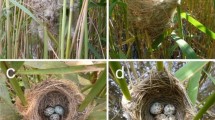Abstract
The host preferences and behaviour of red-billed and yellow-billed oxpeckers (Buphagus erythrorynchus and Buphagus africanus) were studied at two locations in Kenya and combined with previously published data from East and South Africa. Red-billed oxpeckers are generally more common and have a greater niche breadth with respect to host preferences than yellow-billed oxpeckers, possibly due to the behavioural dominance of the latter. Otherwise, the host preferences are remarkably similar: both prefer larger species of ungulates and are found predominantly on species with manes. There are also no significant differences in the time–activity budgets of the two species controlling for site and host species, and differences in the proportion of time spent on different body parts of hosts are small in absolute magnitude even when statistically significant. Despite these and other basic ecological similarities, no evidence for competitive displacement was detected by comparing host preferences in areas of sympatry with areas of allopatry, even though each species appears to depress the population size of the other when sympatric. Traditional single-community competition theory cannot explain the geographical ecology of these two species. Instead, co-existence appears to be dependent on the patterns of extinction and colonization characterized by metapopulations distributed among a fragmented habitat.
Similar content being viewed by others
References
Attwell, R.I.G. (1966) Oxpeckers, and their associations with mammals in Zambia. Puku 4, 17–48.
Bezuidenhout, J.D. and Stutterheim, C.J. (1980) A critical evaluation of the role played by the red-billed oxpecker Buphagus erythrorhynchus in the biological control of ticks. Onderstepoort J. Vet. Res. 47, 51–75.
Breitwisch, R. (1992) Tickling for ticks. Nat. Hist. March, 56–63.
Buskirk, W.H. (1975) Substrate choices of oxpeckers. Auk 92, 604–6.
Colwell, R.L. and Futuyma, D.J. (1971) On the measurement of niche breadth and overlap. Ecology 52, 567–76.
Dale, J. (1992) The effect of the removal of buffalo Syncerus caffer (Sparman 1779) on the host selection of yellow-billed oxpeckers Buphagus africanus Linnaeus 1766 in Zimbabwe. Trop. Ecol. 5, 19–23.
Dean, W.F.J. and MacDonald, I.A.W. (1981) A review of African birds feeding in association with mammals. Ostrich 52, 135–55.
Dorst, J. and Dandelot, P. (1969) A Field Guide to the Larger Mammals of Africa. Houghton Mifflin, Boston, MA.
Gause, G.F. (1971) The Struggle for Existence. Dover, New York.
Grobler, J.H. (1980) Host selection and species preference of the red-billed oxpecker Buphagus erythrorhynchus in the Kruger National Park. Koedoe 23, 89–97.
Grobler, J.H. and Charsley, G.W. (1978) Host preference of the yellow-billed oxpecker Buphagus africanus in the Rhodes Matopos National Park, Rhodesia. S. Afr. J. Wildl. Res. 8, 169–70.
Hanski, I. (1983) Coexistence of competitors in a patchy environment. Ecology 64, 493–500.
Hanski, I. and Gyllenberg, M. (1993) Two general metapopulation models and the core-satellite species hypothesis. Am. Nat. 142, 17–41.
Hanski, I. and Ranta, E. (1983) Coexistence in a patchy environment: three species of Daphnia in rock pools. J. Animal Ecol. 52, 263–79.
Hart, B.L., Hart, L.A. and Mooring, M.S. (1990) Differential foraging of oxpeckers on impala in comparison with sympatric antelope species. Afr. J. Ecol. 28, 240–9.
Hart, B.L., Hart, L.A., Mooring, M.S. and Olubayo, R. (1992) Biological basis of grooming behaviour in antelope: the body-size, vigilance and habitat principles. Animal Behav. 44, 615–31.
Hustler, K. (1987) Host preference of oxpeckers in the Hwange National Park, Zimbabwe. Afr. J. Ecol. 25, 241–5.
Kingdon, J. (1982) East African Mammals, Vol. IIIc. Academic Press, New York.
MacArthur, R.H. (1972) Geographical Ecology. Harper & Row, New York.
Mackworth-Praed, C.W. and Grant, C.H.B. (1960) Birds of Eastern and North Eastern Africa, Vol. II (2nd edn). Longman, London.
McLaughlin, J.F. and Roughgarden, J. (1993) Species interactions in space. In Species Diversity in Ecological Communities (R.E. Ricklefs and D. Schluter, eds), pp. 89–98. University of Chicago Press, Chicago, IL.
Mooring, M.S. and Mundy, P.J. (1996a) Interactions between impala and oxpeckers at Matobo National Park, Zimbabwe. Afr. J. Ecol. 34, 54–65.
Mooring, M.S. and Mundy, P.J. (1996b) Factors influencing host selection by yellow-billed oxpeckers at Matobo National Park, Zimbabwe. Afr. J. Ecol. 34, 177–88.
Neweklowsky, W. (1974) Beobachtungen an Rotschnabelmadenhackern, Buphagus erythrorhynchus (Stanley). Zool. Garten N.F. 44, 121–43.
Olubayo, R., Jonyo, J., Orinda, G., Groothenhuis, J.G. and Hart, B.L. (1993) Comparative differences in density of adult ticks as a function of body size in some East African antelope. Afr. J. Ecol. 31, 26–34.
Skinner, J.D. and Smithers, H.N. (1990) The Mammals of the Southern African Subregion. University of Pretoria, Pretoria.
Slatkin, M. (1974) Competition and regional coexistence. Ecology 55, 128–34.
Stutterheim, C.J. (1980) Symbiont selection of redbilled oxpecker in the Hluhluwe-Umfolozi game reserve complex. Lammergeyer 30, 21–5.
Stutterheim, C.J. (1982) Breeding biology of the redbilled oxpecker in the Kruger National Park. Ostrich 53, 79–90.
Stutterheim, I.M. and Panagis, K. (1985) Roosting behaviour and host selection of oxpeckers (Aves: Buphaginae) in Moremi Wildlife Reserve, Botswana, and eastern Caprivi, South West Africa. S. Afr. J. Zool. 20, 237–40.
Stutterheim, C.J., Mundy, P.J. and Cook, A.W. (1976) Comparisons between the two species of oxpecker. Bokmakierie 28, 12–14.
Stutterheim, I.M., Bezuidenhout, J.D. and Elliott, E.G.R. (1988) Comparative feeding behaviour and food preferences of oxpeckers (Buphagus erythrorhynchus and B. africanus) in captivity. Onderstepoort J. Vet. Res. 55, 173–9.
Van Someren, V.D. (1951) The red-billed oxpecker and its relation to stock in Kenya. E. Afr. Agricult. J. 17, 1–11.
Watkins, B.P. and Cassidy, R.J. (1987) Evasive action taken by waterbuck to redbilled oxpeckers. Ostrich 58, 90.
Whyte, I.J., Hall-Martin, A.J., Kloppers, J.J. and Otto, J.P.A. de T. (1987) The status and distribution of the yellowbilled oxpecker in the Kruger National Park. Ostrich 58, 88–90.
Author information
Authors and Affiliations
Rights and permissions
About this article
Cite this article
Koenig, W.D. Host preferences and behaviour of oxpeckers: co-existence of similar species in a fragmented landscape. Evolutionary Ecology 11, 91–104 (1997). https://doi.org/10.1023/A:1018439614008
Issue Date:
DOI: https://doi.org/10.1023/A:1018439614008




